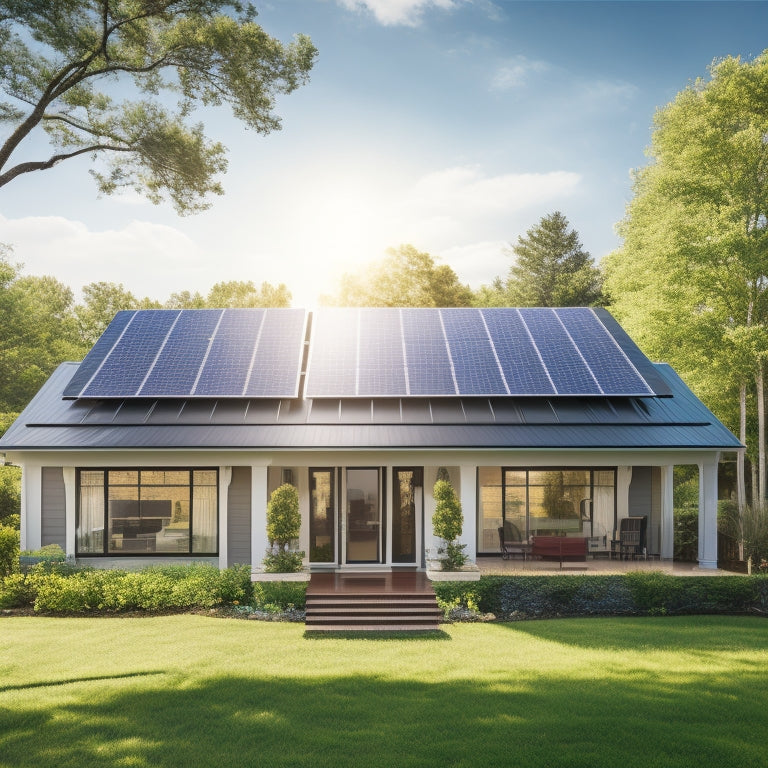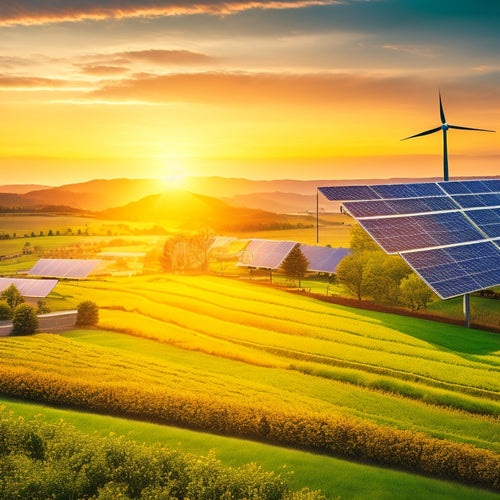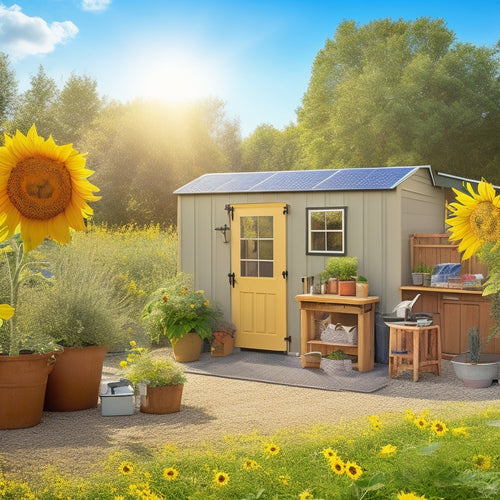
Home Solar Installation Cost
Share
You're considering installing solar panels on your home, and the upfront cost is likely the biggest hurdle standing in your way. The cost of home solar installation varies depending on factors like roof size, panel type, and installation methods. Monocrystalline panels, though more expensive, offer superior performance and space efficiency. Polycrystalline panels, on the other hand, are more affordable but produce less energy per hour. Evaluating your roof's size and shape is essential, as irregular shapes can affect panel placement and efficiency. By understanding the costs and benefits, you'll be able to make an informed decision and access long-term energy savings - and there's more to investigate to help you get started.
The Essentials
- The cost of home solar installation varies depending on panel type, with monocrystalline panels costing 10%-15% more upfront than polycrystalline panels.
- Installation costs can be offset by long-term energy independence benefits, tax credits, and potential energy savings, making monocrystalline panels a premium option.
- Average annual savings for homeowners with solar panels range from $400 to $1,000, depending on energy usage and net metering programs.
- Roof size, shape, and complexity can impact installation costs, with irregular shapes and multiple skylights or vents increasing expenses.
- Solar incentives, including tax credits and rebates, can make installation more affordable, with homeowners potentially recouping up to 100% of installation costs at resale.
Reduce Carbon Footprint Easily
You can take a significant step towards reducing your carbon footprint by switching to a renewable energy source like solar power.
By going green today, you'll not only contribute to a cleaner environment but also save on energy costs in the long run.
With Solar Battery Systems, you can store excess energy generated during the day for use during the night or on cloudy days, ensuring a reliable supply of power.
As an eco-friendly energy source, solar power offers a guilt-free way to power your home while minimizing your impact on the planet.
Go Green Today
A growing awareness of climate change has sparked a sense of urgency among homeowners to reduce their carbon footprint. You're likely no exception, and that's why you're considering going green with solar energy.
Installing rooftop solar panels can greatly lower your monthly electricity bills by utilizing free, renewable energy from the sun solar panel installation for homes, and increase your home's value and appeal.
The good news is that it's easier than you think to make the switch. With solar incentives like tax credits and rebates, the cost of installation is more affordable than ever.
Plus, the installation process is relatively straightforward. A professional installer will assess your energy needs, design a system customized to your home, and handle the permitting and installation.
You'll be generating clean energy in no time.
Eco-Friendly Energy Source
Your home's reliance on fossil fuels is a considerable contributor to greenhouse gas emissions, but solar energy offers a cleaner alternative. By switching to solar power, you can reduce your carbon footprint easily and considerably decrease your impact on the environment.
With a home energy system, you can overcome three major pain points that come with traditional energy sources: hefty monthly energy expenses, and also enjoy increased energy independence. As an eco-friendly energy source, solar power is a wise investment for homeowners who value freedom from reliance on finite resources. You can capture the sun's energy to power your home, reducing your dependence on fossil fuels and minimizing your contribution to climate change.
The installation process is straightforward, and solar incentives are available to offset the cost. In fact, the cost of solar panels has decreased dramatically over the years, making it more accessible to homeowners.
With solar energy, you can enjoy lower energy bills, increased property value, and a clear conscience. By choosing solar power, you're not only reducing your carbon footprint but also contributing to a sustainable future for generations to come.
Increases Property Value Instantly
You'll likely see an immediate increase in your property's value once you install solar panels, thanks to the enhancement they give to your home's appeal and marketability.
According to various studies, solar-powered homes have higher residential solar installation demand, which can lead to increased property values.
In fact, studies have shown that renewable energy upgrades like solar panels can increase property value by up to 17%.
Solar Panels Boost Value
Solar panels considerably enhance property value, a benefit that's undeniable in today's real estate market. You're not just investing in a sustainable energy solution, but also elevating your property's appeal to potential buyers. According to the National Renewable Energy Laboratory, solar panels can increase your property value by up to $15,000. This increased value is due to the financial incentives associated with solar panels, such as reduced energy bills and potential tax credits.
During the installation process, you'll likely see an immediate increase in your property's value. This is because solar panels are viewed as a desirable feature, much like a newly renovated kitchen or bathroom.
As you consider installing solar panels, keep in mind that they can recoup up to 100% of their cost at resale. This means you'll not only benefit from reduced energy bills while you own the property, but also reap the financial rewards when it's time to sell.
Renewable Energy Upgrades
Renewable energy upgrades, including solar panels, are a key component of increasing property value instantly. You can greatly enhance your property's appeal and worth by investing in clean energy solutions.
Not only do solar panels reduce your reliance on the grid, but they also provide a tangible asset that adds value to your home. With solar incentives, such as the federal solar investment tax credit, you can offset the initial installation cost, making it a more attractive investment.
Additionally, renewable energy upgrades provide energy independence, allowing you to generate your own power and reduce your utility bills. This can be a major selling point for potential buyers, as it not only saves them money but also contributes to a sustainable future.
Monocrystalline Vs Polycrystalline Panels
When selecting solar panels, you'll likely come across two main types: monocrystalline and polycrystalline.
You'll want to take into account the efficiency of each, as monocrystalline panels boast higher efficiency rates, typically ranging from 15% to 20%, compared to polycrystalline panels, which usually fall between 12% and 15%.
Importantly, residential solar panel systems often employ monocrystalline panels due to their superior performance.
Additionally, monocrystalline panels tend to be more space-efficient, allowing for more power generation in a smaller area.
The cost difference between these two options is also significant, and understanding these variations will help you make an informed decision for your home solar installation.
Panel Efficiency Comparison
Your roof is about to become a powerhouse, utilizing the sun's energy to power your home. As you consider capturing solar energy, it's crucial to understand the differences between monocrystalline and polycrystalline panels.
When it comes to panel efficiency, monocrystalline panels have a slight edge over polycrystalline ones. Monocrystalline panels have an average efficiency rate of 20-22%, while polycrystalline panels average around 18-20%. This means monocrystalline panels can convert more sunlight into electricity per hour.
However, this doesn't necessarily translate to better panel performance. Polycrystalline panels often have better temperature tolerance, making them more suitable for hot climates.
Additionally, installation techniques can also impact panel efficiency. For instance, using a tracking system that adjusts the panel's angle to follow the sun's movement can enhance energy production.
Ultimately, the choice between monocrystalline and polycrystalline panels depends on your specific energy needs, budget, and climate.
Cost Difference Analysis
About 10-15% more expensive upfront, monocrystalline solar panels are often considered a premium option. You'll need to weigh this higher initial cost against the benefits they offer.
While polycrystalline panels are more affordable, monocrystalline panels produce more power per hour of sunlight, resulting in higher energy independence.
When considering your installation factors, financing options, and local incentives, you should also think about long-term savings. Monocrystalline panels tend to last longer, reducing maintenance costs over time.
Additionally, you may be eligible for higher tax credits with monocrystalline panels.
However, it's important to balance these advantages with your installation timeline and contractor selection. Some contractors may offer better warranty coverage for monocrystalline panels, but this may impact your upfront cost.
Assess Roof Size First
When calculating your home solar installation cost, you'll need to assess your roof size first. The size of your roof matters because it determines how many solar panels you can fit, and subsequently, how much energy you can generate.
You'll also need to take into account the shape of your roof, as irregular shapes can affect the placement and efficiency of your solar panels.
Since you're exploring renewable energy systems, it's crucial to contemplate off-grid energy solutions that cater to your specific needs.
Additionally, understanding energy efficiency solutions can help you make informed decisions about your home's energy requirements.
Roof Size Matters
Since residential solar panels typically cover a significant portion of your roof, analyzing its size is vital in determining the number of panels you can install and, consequently, the overall cost of your home solar installation.
When evaluating your roof size, you'll want to take into account the roof orientation. A south-facing roof is ideal, as it receives the most sunlight throughout the day. An east- or west-facing roof can still accommodate solar panels, but you may need more of them to generate the same amount of energy.
Shading effects also play a significant role in determining the number of panels you can install. If your roof is partially shaded by trees, buildings, or other obstructions, you may need to install more panels to compensate for the lost energy production.
A larger roof provides more space to work around shading effects, allowing you to install a more efficient solar panel system.
Roof Shape Affects
Beyond roof size, its shape also plays an important role in determining the feasibility and cost of your home solar installation. You'll need to evaluate your roof's shape to guarantee a successful installation. A complex roof shape can lead to installation challenges, increasing the overall cost.
For instance, a roof with multiple skylights, vents, or steep angles can make it difficult for installers to maneuver, resulting in higher labor costs.
The roof angle is also vital, as it affects the solar panels' energy output. A roof with a shallow angle may not be suitable for solar panels, as debris can accumulate and reduce energy production.
On the other hand, a roof with a steep angle may require specialized mounting systems, adding to the installation cost. You'll need to take these factors into account when determining the best solar panel configuration for your roof.
Lower Electricity Bills Guaranteed
You'll start saving money monthly on your electricity bills once you've installed solar panels on your roof.
Your new solar system will generate free energy, reducing your reliance on the grid and lowering your utility bills.
Save Money Monthly
Your electricity bills are likely one of your largest monthly expenses, but with a home solar installation, you can greatly reduce this cost. By utilizing the power of the sun, you'll generate clean energy and lower your reliance on the grid. This translates to significant financial benefits and monthly savings.
On average, homeowners who install solar panels can save between $400 and $1,000 per year on their electricity bills. These savings can add up quickly, and over the lifespan of your solar system, you can expect to save thousands of dollars.
In addition, many utility companies offer net metering programs, which allow you to sell excess energy back to the grid and further reduce your bills. With a home solar installation, you'll enjoy predictable monthly savings, shielding you from rising electricity rates and giving you more control over your energy expenses.
Frequently Asked Questions
Can I Install Solar Panels on a Metal or Tile Roof?
You can install solar panels on both metal and tile roofs, but you'll need to take into account metal roof considerations like waterproofing and tile roof advantages like ease of installation, ensuring a secure and efficient solar setup that grants you energy independence.
How Long Does the Solar Panel Installation Process Take?
You'll find the solar panel installation process typically takes 3-5 days, but it can stretch up to several weeks if you're dealing with installation challenges like complex roof layouts or permitting issues, affecting your installation timeline.
Are Solar Panels Covered by Homeowner's Insurance?
You'll be glad to know that your solar panels are typically covered by your homeowner's insurance, which provides insurance coverage up to your policy limits, giving you financial protection against damage, theft, or other unforeseen events.
What Happens to Solar Panels During a Power Outage?
Imagine being a shipwrecked sailor, adrift in darkness, until you utilize the sun's power. During a power outage, you'll stay afloat with solar panels, which automatically shut off to guarantee solar panel safety; meanwhile, power outage solutions like battery backups keep your lights on, granting you freedom from darkness.
Can I Install Solar Panels Myself to Save Money?
You can attempt a DIY solar installation to reap cost savings, but be aware that it requires extensive knowledge of electrical systems, local building codes, and safety protocols to avoid costly mistakes and guarantee a safe, efficient setup.
Final Thoughts
As you weigh the pros and cons of home solar installation, remember that the upfront cost is a small price to pay for the long-term benefits. By utilizing the power of the sun, you're not only reducing your carbon footprint but also increasing your property's value and slashing your electricity bills. The question isn't whether you can afford to go solar, but can you afford not to?
Related Posts
-

Net Metering in Renewable Energy's Future
Net metering's future is vital for driving renewable energy growth and financial savings. You can reduce your electri...
-

Building an Emergency Backup Solar Power System in 5 Essential Steps
Building an emergency backup solar power system involves five key steps. First, assess your daily energy needs to ide...
-

Essential Hiking Lights for Safety and Fun
When you're hitting the trails, essential hiking lights are vital for safety and fun. A lightweight headlamp offers h...


